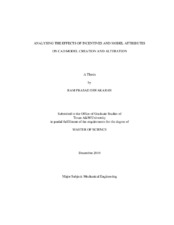| dc.contributor.advisor | Linsey, Julie | |
| dc.contributor.advisor | Johnson, Michael D. | |
| dc.creator | Diwakaran, Ram Prasad | |
| dc.date.accessioned | 2012-02-14T22:19:10Z | |
| dc.date.accessioned | 2012-02-16T16:20:35Z | |
| dc.date.available | 2012-02-14T22:19:10Z | |
| dc.date.available | 2012-02-16T16:20:35Z | |
| dc.date.created | 2010-12 | |
| dc.date.issued | 2012-02-14 | |
| dc.date.submitted | December 2010 | |
| dc.identifier.uri | https://hdl.handle.net/1969.1/ETD-TAMU-2010-12-9032 | |
| dc.description.abstract | Modern computer-aided design (CAD) systems have contributed significantly towards product development cycle time reduction and product quality improvement. To enhance the performance of CAD systems engineers must be able to create CAD models of conceptual designs quickly; at the same time CAD models must be easy to alter, so as to accommodate the rapid changes that the design undergoes through the lifecycle. However, there is no agreement in the way CAD models should be created to accomplish these goals. This work attempts to assess the effects of incentives on CAD model attributes during model creation and alteration; the effects of CAD model attributes on alteration are also investigated. Its aim is to derive prescriptions based on empirical evidence to improve CAD model creation and alteration efficiency.
The CAD models under study are created by three sets of participants – students from a junior level CAD course, students from a senior level CAD course and experienced engineers involved in product development activities. The participants are incentivized to create and alter CAD models of designs they are provided with. The results indicate that upon removal of incentives, engineers (both students and professionals) tend to compromise on proper modeling procedures. Experts are quicker and adhere to commonly agreed correct modeling procedures during CAD model creation and alteration than students. The results also indicate that it is beneficial for alteration to construct a model with several simple features as opposed to a few complex features and that these features be fully constrained. Maintaining the traditional feature sequence improves the perception of the model. The retention and alteration of features (as opposed to deletion) is also shown to be positively correlated with model perception ratings. | en |
| dc.format.mimetype | application/pdf | |
| dc.language.iso | en_US | |
| dc.subject | Computer-Aided Design | en |
| dc.subject | Incentives | en |
| dc.subject | Expertise | en |
| dc.subject | CAD model creation | en |
| dc.subject | CAD model alteration | en |
| dc.title | Analysing the Effects of Incentives and Model Attributes on CAD Model Creation and Alteration | en |
| dc.title.alternative | Analyzing the Effects of Incentives and Model Attributes on CAD Model Creation and Alteration | en |
| dc.type | Thesis | en |
| thesis.degree.department | Mechanical Engineering | en |
| thesis.degree.discipline | Mechanical Engineering | en |
| thesis.degree.grantor | Texas A&M University | en |
| thesis.degree.name | Master of Science | en |
| thesis.degree.level | Masters | en |
| dc.contributor.committeeMember | Schwartz, Cris | |
| dc.type.genre | thesis | en |
| dc.type.material | text | en |


